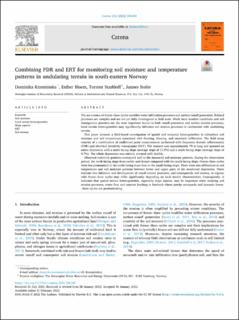| dc.contributor.author | Krzeminska, Dominika | |
| dc.contributor.author | Bloem, Esther | |
| dc.contributor.author | Starkloff, Torsten | |
| dc.contributor.author | Stolte, Jannes | |
| dc.date.accessioned | 2022-09-20T18:41:36Z | |
| dc.date.available | 2022-09-20T18:41:36Z | |
| dc.date.created | 2022-02-23T09:23:33Z | |
| dc.date.issued | 2022-02-21 | |
| dc.identifier.citation | Krzeminska, D., Bloem, E., Starkloff, T., & Stolte, J. (2022). Combining FDR and ERT for monitoring soil moisture and temperature patterns in undulating terrain in south-eastern Norway. CATENA, 212, 106100. | en_US |
| dc.identifier.issn | 0341-8162 | |
| dc.identifier.uri | https://hdl.handle.net/11250/3020025 | |
| dc.description.abstract | The occurrence of freeze–thaw cycles modifies water infiltration processes and surface runoff generation. Related processes are complex and are not yet fully investigated at field scale. While local weather conditions and soil management practices are the most important factors in both runoff generation and surface erosion processes, local terrain heterogeneities may significantly influence soil erosion processes in catchments with undulating terrain. This paper presents a field-based investigation of spatial and temporal heterogeneities in subsurface soil moisture and soil temperature associated with freezing, thawing, and snowmelt infiltration. The field setup consists of a combination of traditional point measurements performed with frequency domain reflectometry (FDR) and electrical resistivity tomography (ERT). The transect was approximately 70 m long and spanned an entire depression with a north-facing slope (average slope of 11.5%) and a south-facing slope (average slope of 9.7%). The whole depression was entirely covered with stubble. Observed resistivity patterns correspond well to the measured soil moisture patterns. During the observation period, the north facing slope froze earlier and deeper compared with the south facing slope. Freeze–thaw cycles were less pronounced in the north-facing slope than in the south-facing slope. There were also differences in soil temperature and soil moisture patterns between lower and upper parts of the monitored depression. These indicate that initiation and development of runoff related processes, and consequently soil erosion, in regions with freeze–thaw cycles may differ significantly depending on local terrain characteristics. Consequently, it indicates that spatial terrain heterogeneities, especially slope aspects, may be important when studying soil erosion processes, water flow and nutrient leaching in lowlands where patchy snowpacks and dynamic freeze–thaw cycles are predominating. | en_US |
| dc.language.iso | eng | en_US |
| dc.publisher | Elsevier B.V. | en_US |
| dc.rights | Navngivelse 4.0 Internasjonal | * |
| dc.rights.uri | http://creativecommons.org/licenses/by/4.0/deed.no | * |
| dc.title | Combining FDR and ERT for monitoring soil moisture and temperature patterns in undulating terrain in south-eastern Norway | en_US |
| dc.title.alternative | Combining FDR and ERT for monitoring soil moisture and temperature patterns in undulating terrain in south-eastern Norway | en_US |
| dc.type | Peer reviewed | en_US |
| dc.type | Journal article | en_US |
| dc.description.version | publishedVersion | en_US |
| dc.rights.holder | © 2022 The Authors | en_US |
| dc.source.pagenumber | 10 | en_US |
| dc.source.volume | 212 | en_US |
| dc.source.journal | CATENA | en_US |
| dc.identifier.doi | 10.1016/j.catena.2022.106100 | |
| dc.identifier.cristin | 2004724 | |
| dc.source.articlenumber | 106100 | en_US |
| cristin.ispublished | true | |
| cristin.fulltext | original | |
| cristin.qualitycode | 1 | |

